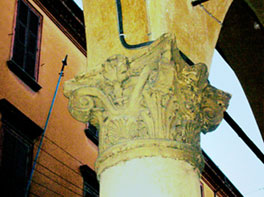|
BED AND BREAKFAST IN BOLOGNA ACCOMMODATION IN BOLOGNA ERBORISTERIA WEBMASTER |
||||||
|
|
At the beginning of the 5th Century
AD. the town
was falling apart; in this
period Bishop Petronius, returned after carrying out political duties in
Spain, Milan and Gaul and became very
popular for the
important urbanisation works he carried out. History tells us that Bishop
Petronius marked the perimeter of the town with four crosses (they are all
kept in St. Petronio, and in fact, date back to the time of Liutprand);
this act is said to have been the origin of the so called "cerchia
di Selenite" (selenite
circle), while another opinion ascribes the origin of this circle to
King Theodoric. The perimeter of the "cerchia di selenite" which encircled
a much smaller town than the Roman one was marked by four gates: the
"Piera" and the "Procola" at the two ends of the
main "cardo"; As we often say Bishop Petronius became popular not only because he acted along traditional lines, that is to say promoting the construction of civic buildings, but also because he created the St. Stephen group, originally called "Sancta Jerusalem" because it evocated in its layout the Holy Places; in this group, the Holy Sepulchre church houses his tomb. |
|
b u |
|||
|
General - Environment - Iron and Etruscan Age - Roman Age - Patron Saint- The Commune - Alma mater studiorum - Re Enzo - Porticoes - St Peter - Gothic - 14th Century - Piazza Maggiore - Aristocratic palaces - Brick and other stones - Early 15th Century - Archiginnasio - Counter Reformation Renaissance - 16th Century - Great portico ribbons - Frescoes in palaces - The "scenographic" city - Napoleon's republics - Fall of Church power - The Restoration - Haussmann style - The new Century - Floreal style - Rationalism - World War - Active preservation - Around 2000 |
||||||
